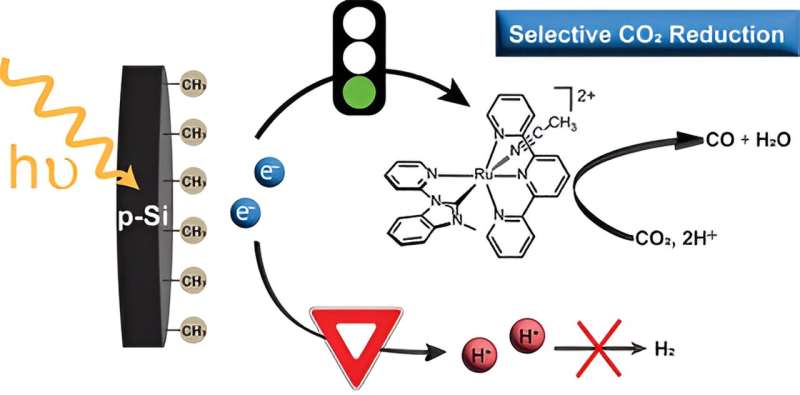This article has been reviewed according to Science X's editorial process and policies. Editors have highlighted the following attributes while ensuring the content's credibility:
fact-checked
peer-reviewed publication
trusted source
proofread
Chemistry researchers modify solar technology to produce a less harmful greenhouse gas

Researchers in the UNC-Chapel Hill Chemistry Department are using semiconductors to harvest and convert the sun's energy into high-energy compounds that have the potential to produce environmentally friendly fuels.
In the paper, "Methyl termination of p-Type silicon enables selective photoelectrochemical CO2 reduction by a molecular ruthenium catalyst," published in ACS Energy Letters, the researchers explain how they use a process called methyl termination that uses a simple organic compound of one carbon atom bonded to three hydrogen atoms to modify the surface of silicon, an essential component in solar cells, to improve its performance in converting carbon dioxide into carbon monoxide using sunlight.
The research was informed by a process called artificial photosynthesis, which mimics how plants use sunlight to convert carbon dioxide into energy-rich molecules.
Carbon dioxide is a major greenhouse gas contributing to climate change. By converting it to carbon monoxide, which is a less harmful greenhouse gas and a building block for more complex fuels, the researchers said they could potentially mitigate the environmental impact of carbon dioxide emissions.
"One challenge with solar energy is that it's not always available when we have the highest need for it," said Gabriella Bein, the paper's first author and a Ph.D. student in chemistry. "Another challenge is that renewable electricity, like that from solar panels, doesn't directly provide the raw materials needed for making chemicals. Our goal is to store solar power in the form of liquid fuels that can be used later."
The researchers used a ruthenium molecular catalyst with a piece of chemically modified silicon, called a photoelectrode, that facilitated the conversion of carbon dioxide to carbon monoxide using light energy without producing unwanted byproducts, such as hydrogen gas, making the process more efficient for converting carbon dioxide into other substances.
Jillian Dempsey, a co-author of the paper and Bowman and Gordon Gray Distinguished Term Professor, said that when they ran experiments in a solution filled with carbon dioxide, they found that they could produce carbon monoxide at 87% efficiency, meaning the system using the modified silicon photoelectrodes is comparable or better than systems using traditional metal electrodes, such as gold or platinum.
In addition, the silicon photoelectrode used 460 millivolts less electrical energy to produce a reaction than one would have using only electricity. Dempsey called this significant because the process uses direct light harvesting to supplement or offset the energy required to drive the chemical reaction that converts carbon dioxide into carbon monoxide.
"What's interesting is normally silicon surfaces make hydrogen gas instead of carbon monoxide, which makes it harder to produce it from carbon dioxide," said Dempsey.
"By using this special methyl-terminated silicon surface, we were able to avoid this problem. Modifying the silicon surface makes the process of converting CO2 into carbon monoxide more efficient and selective, which could be really useful for making liquid fuels from sunlight in the future."
More information: Gabriella P. Bein et al, Methyl Termination of p-Type Silicon Enables Selective Photoelectrochemical CO2 Reduction by a Molecular Ruthenium Catalyst, ACS Energy Letters (2024). DOI: 10.1021/acsenergylett.4c00122


















